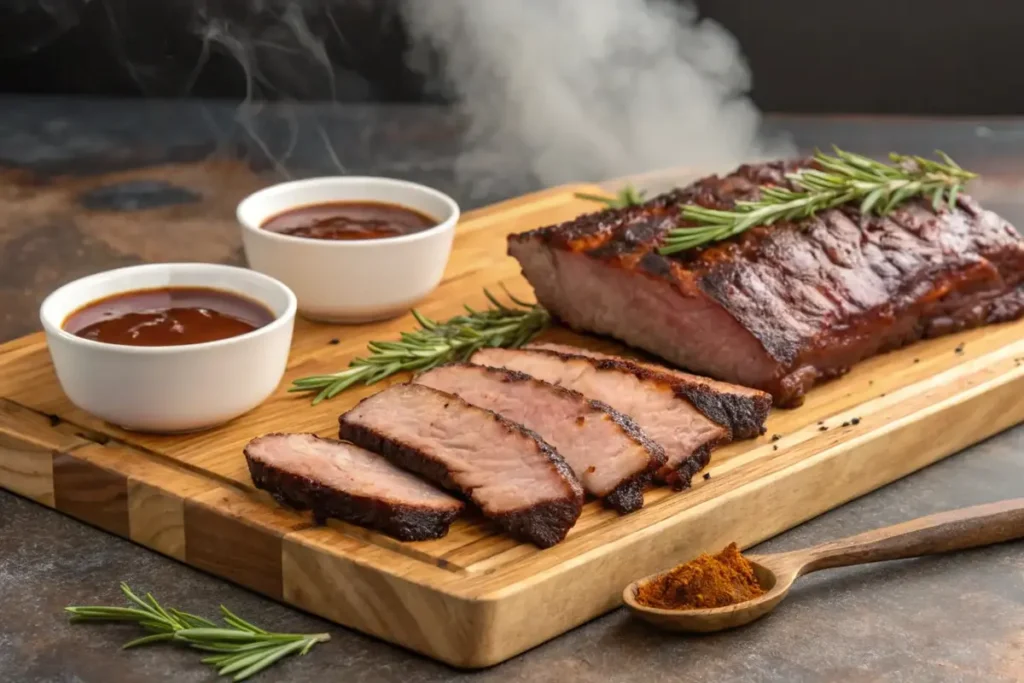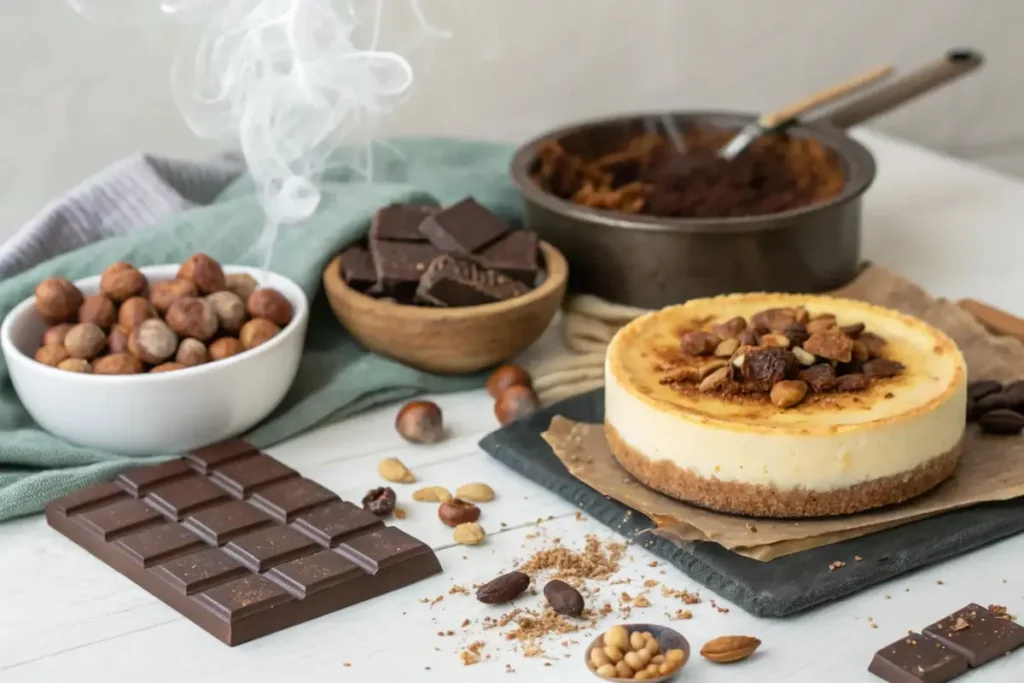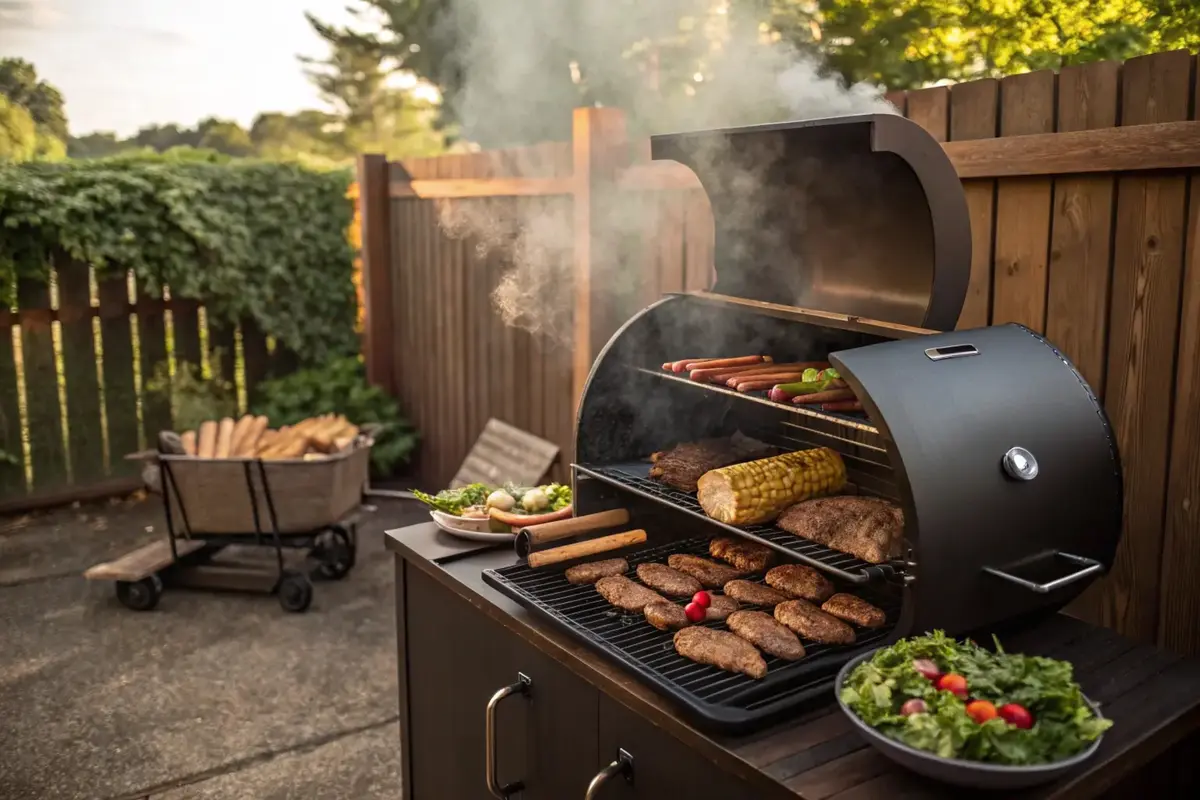Introduction
Smoking food is more than a cooking technique—it’s an art that transforms simple ingredients into mouthwatering creations. Whether you’re a meat lover, a seafood enthusiast, or a vegetarian, there’s no shortage of options when it comes to the best foods to cook in a smoker. This guide will walk you through the science behind smoking, the top foods to try, and even some unexpected items you didn’t know could be smoked. Ready to elevate your cooking skills? Let’s dive in!
Part 1: Why Smoking Enhances Flavor
The Science Behind Smoking Food
Smoking is a low-and-slow cooking method that imparts flavor, tenderizes food, and adds a unique aroma to dishes. The magic happens when smoke from burning wood interacts with food, infusing it with rich, smoky notes.
The secret lies in the chemical compounds within the smoke—like phenols, carbonyls, and acids—which penetrate the surface of the food, creating layers of flavor. When combined with the natural juices of the ingredients, this process produces the irresistible taste we associate with smoked dishes.
Smoke Infusion and Wood Types
Not all smoke is created equal! The type of wood you use can make or break your dish. Here are a few popular options:
- Hickory: Perfect for bold meats like beef and ribs, hickory adds a strong, savory flavor.
- Applewood: Great for poultry and pork, applewood brings a sweet, fruity note.
- Mesquite: Known for its intense smokiness, mesquite is ideal for red meats but should be used sparingly.
- Cherry: A versatile wood that works well with vegetables and lighter meats, offering a mild sweetness.
Part 3: Best Meats to Cook in a Smoker
Top Choices for Smoked Meats
When it comes to smoking, meat takes center stage. From the rich, marbled brisket to tender pork ribs, smoked meats are a culinary favorite for good reason. Let’s explore the top options and how to make the most of them.
Brisket
Brisket is often called the king of smoked meats, and for good reason. Its marbling and connective tissue break down beautifully during the low-and-slow cooking process, creating a tender, juicy masterpiece.
- Why It’s a Favorite: Brisket is a large, hearty cut that absorbs smoky flavors exceptionally well. Its rich taste and melt-in-your-mouth texture make it a go-to for barbecue lovers.
- Tips for Smoking Brisket:
- Trim excess fat, leaving a thin layer to protect the meat during cooking.
- Apply a flavorful dry rub and let it rest overnight for maximum flavor absorption.
- Smoke at 225°F for about 12–14 hours, using woods like oak or hickory.
- Wrap in butcher paper once it hits 165°F to retain moisture and finish cooking.
Pork Shoulder and Ribs
Pork is another excellent choice for smoking, offering unparalleled tenderness and flavor when done right.
- Tenderness and Flavor: Cuts like pork shoulder and ribs are rich in connective tissue, which breaks down over time to create a succulent, flavorful result.
- Step-by-Step Guide for Ribs:
- Remove the membrane from the ribs for better smoke penetration.
- Coat generously with a dry rub and let them rest for 30 minutes.
- Smoke at 225°F for 3 hours using cherry or applewood for a slightly sweet flavor.
- Wrap in foil with a splash of apple juice and smoke for another 2 hours.
- Finish unwrapped for 1 hour, applying barbecue sauce to caramelize.
Chicken and Turkey
Poultry is a versatile choice for smoking, but keeping it moist can be a challenge.
- Best Practices for Poultry:
- Brine the bird overnight to retain moisture and infuse flavor.
- Use a mild wood like pecan or applewood to avoid overpowering the meat.
- Smoke at 225°F until the internal temperature reaches 165°F in the breast and 175°F in the thigh.
Whether it’s a whole chicken or a Thanksgiving turkey, smoked poultry delivers juicy, flavorful results every time.
Sausages and Game Meats
For a more adventurous option, try smoking homemade sausages or game meats like venison.
- Why They Work Well: Sausages absorb smoke quickly, while game meats benefit from the added moisture and smoky flavor.
- Tips for Smoking:
- Use natural casings for sausages and season with bold spices.
- Smoke at a low temperature (160°F–180°F) to prevent splitting.
- For venison or other game, marinate beforehand to counteract the natural leanness.

Part 4: Best Seafood for the Smoker
Elevating Seafood with Smoking Techniques
Smoking seafood adds a depth of flavor that can’t be achieved through other cooking methods. Here are some of the best options for your smoker.
Salmon
Salmon is one of the most popular seafood choices for smoking, thanks to its rich, fatty texture.
- Why It’s Ideal: Its natural oils help it stay moist during smoking, and it absorbs smoky flavors beautifully.
- Recipe Ideas for Smoked Salmon:
- Brine the salmon in a mixture of water, salt, and brown sugar for 8–12 hours.
- Pat dry and let it form a pellicle before smoking.
- Smoke at 160°F–180°F with alder or maple wood for 2–4 hours.
Serve your smoked salmon with crackers, cream cheese, or in salads for a versatile treat.
Shrimp and Scallops
Quick-cooking and delicate, shrimp and scallops are perfect for adding a touch of smokiness without overpowering their natural sweetness.
- Quick Smoking Techniques:
- Marinate shrimp and scallops in olive oil, garlic, and herbs for 30 minutes.
- Smoke at 225°F for 30–45 minutes using mild woods like cherry or alder.
- Serve as an appetizer or in pasta dishes for a smoky twist.
Oysters and Mussels
Smoking shellfish brings out their natural brininess while adding a rich, smoky dimension.
- How to Smoke Shellfish:
- Clean the shells and place them directly on the smoker rack.
- Smoke at 225°F for 30–40 minutes until the shells open and the meat is firm.
- Add a squeeze of lemon or a dab of garlic butter before serving.
Smoked seafood is a showstopper at any gathering, offering an elegant and flavorful alternative to traditional dishes.
Part 5: Vegetarian and Vegan Smoker Options
Plant-Based Foods for Smoking
Smoking isn’t just for meats and seafood—plant-based foods can also shine in the smoker, offering a wealth of smoky, rich flavors. Whether you’re enhancing vegetables, proteins, or snacks, smoking opens up endless possibilities for vegetarians and vegans.
Vegetables
Vegetables are incredibly versatile in the smoker and absorb smoky flavors beautifully.
- Best Vegetables to Smoke:
- Bell Peppers: Their natural sweetness pairs well with a hint of smokiness.
- Zucchini: Soft and tender, zucchini takes on a rich, savory flavor in the smoker.
- Corn on the Cob: Smoking enhances the natural sweetness of corn while adding a deep, smoky aroma.
- Tips for Enhancing Flavor:
- Toss vegetables in olive oil, garlic, and your favorite spices before smoking.
- Use mild woods like apple or cherry to complement the natural flavors of the veggies.
- Smoke at 225°F for 45–60 minutes, checking for tenderness along the way.
Smoked vegetables are perfect as a side dish, in salads, or even as a main course for a light, smoky meal.
Tofu and Tempeh
Plant-based proteins like tofu and tempeh gain depth and complexity when smoked.
- How Smoking Adds Depth:
- Press tofu to remove excess water, then marinate it in soy sauce, garlic, and liquid smoke.
- Smoke at 225°F for 1–2 hours using maple or pecan wood.
- For tempeh, slice it thinly and marinate it in a mixture of balsamic vinegar and spices before smoking.
Smoked tofu and tempeh are excellent in sandwiches, stir-fries, or as a protein-packed topping for salads.
Smoked Nuts and Cheeses
Smoking nuts and cheeses transforms them into gourmet treats, perfect for snacking or entertaining.
- Creating Gourmet Snacks:
- Toss almonds, cashews, or pecans in olive oil and a sprinkle of seasoning. Smoke at 225°F for 1–2 hours with hickory or pecan wood.
- For cheeses like cheddar or gouda, use a cold-smoking method to infuse flavor without melting. Smoke for 2–3 hours with applewood.
Smoked nuts are perfect for trail mixes, while smoked cheeses elevate charcuterie boards and pasta dishes.
Part 6: Experimenting with Unique Smoker Recipes
Unconventional Foods to Smoke
Think beyond traditional ingredients—smoking can enhance unexpected foods in ways you might not imagine. Let’s explore some unconventional options.
Desserts
Adding a smoky twist to sweets creates a balance of flavors that surprises and delights.
- Smoky Cheesecake: Smoke the crust briefly before assembling the cheesecake for a subtle smoky aroma.
- Smoked Fruits: Try smoking apples, peaches, or pineapples for a caramelized, smoky dessert.
- Smoked Chocolate: Place chocolate in the smoker for a short time to infuse it with a hint of smokiness, perfect for s’mores or fondue.
Grains and Legumes
Smoking grains and legumes can elevate everyday dishes with a rich, earthy flavor.
- Smoking Rice and Quinoa: Spread uncooked rice or quinoa on a tray and smoke at 225°F for about 30 minutes. Use the smoked grains in pilafs or salads.
- Beans: Smoke cooked beans like chickpeas or black beans for use in soups, dips, or grain bowls.
These creative options highlight how versatile smoking can be, allowing you to experiment with bold flavors and unique combinations.

Part 7: Frequently Asked Questions (FAQs)
FAQs About the Best Foods to Smoke
What is the easiest meat to smoke for beginners?
For those new to smoking, pork shoulder and chicken thighs are excellent choices. They are forgiving cuts that remain tender even if the cooking time isn’t perfect. These options also absorb smoky flavors well, making them ideal for honing your smoking skills.
Can I smoke multiple types of food at once?
Yes, but it requires careful planning. Foods with similar cooking times and complementary flavors work best together. For example, smoking chicken and vegetables simultaneously can yield great results. Use separate racks to prevent cross-contamination and consider the strength of the smoke to ensure balance.
How long does it take to smoke vegetables compared to meat?
Vegetables typically require less time to smoke, often taking 30–60 minutes, depending on the type and size. Meats, on the other hand, can take several hours or more. Always check for tenderness in vegetables and use a meat thermometer for precise doneness in meats.
What wood is best for smoking seafood?
Mild woods like alder, apple, and cherry are ideal for seafood. They provide a gentle, sweet smoke that enhances the delicate flavors of fish and shellfish without overpowering them. Avoid strong woods like mesquite, which can overwhelm seafood’s natural taste.
Can desserts really be smoked without overpowering sweetness?
Absolutely! The key is to use light smoke and mild woods like maple or fruitwoods. For example, smoking cheesecake crust or fruits adds a subtle smoky flavor that complements the sweetness rather than overpowering it.
Are there any foods that shouldn’t be smoked?
Some foods don’t fare well in a smoker. Leafy greens, for instance, can wilt and lose their texture, while delicate herbs might burn too quickly. Additionally, avoid smoking highly processed foods, as they might not benefit from the flavor infusion.
Part 8: Conclusion
Discovering Your Favorite Foods to Smoke
From tender meats to vibrant vegetables and even unique treats like desserts, the possibilities for the best foods to cook in a smoker are endless. This guide has explored top choices, helpful techniques, and creative recipes to inspire your next smoking session.
Whether you’re a beginner experimenting with chicken wings or an enthusiast exploring smoked fruits, the key to success lies in patience and practice. Don’t be afraid to mix things up—try different woods, seasonings, and recipes to discover your personal favorites.
Remember, smoking is as much about the journey as it is about the destination. So fire up your smoker, embrace the process, and enjoy the smoky, delicious results!

